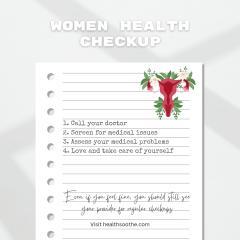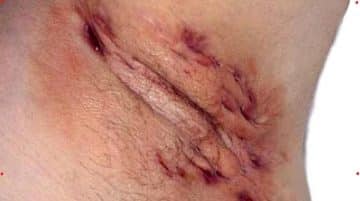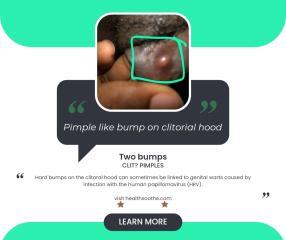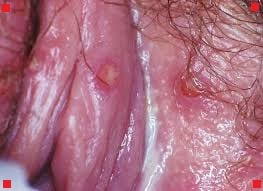Pimple-like bump on clitoral hood is not a good sight, even though it is possibly hidden for the most part of the day. Other people may not see it, but for you who bear it around, you are probably not happy about it. Although pimples appear almost everywhere on the body, the clitoral hood inclusive is the last place you will expect a bump to appear.
Quick Facts About Pimple-Like Bump on Clitoral Hood
Its appearance only resounds the importance of cleanliness. With top-notch hygiene, there is hardly any chance for pimples or bumps that look like it to spring up on any part of the body. However, when they appear, you should be able to know why they appeared and what you can do to make them leave as soon as possible.
This article has the objective of providing you with the possible causes of the pimple-like bumps on clitoral hood and how you can treat them if you can handle them on your own. Also, you will get to know how to ascertain if the bump is just vaginal pimple or something more serious. After reading this piece and all signs point to something other than vaginal pimples, you should visit an obstetrician as soon as possible.

What Could the Pimple-like Bump on Clitoral Hood mean?
The vagina is a sensitive area of the female body. Although the whole of the external female genitalia is called vagina, the clitoral hood is the stretch of skin that covers the sensitive part that resembles the male sex organ, only that is smaller – the clitoris.
Pimple-like bumps around the vagina is not usually considered a serious problem. However, it can cause some level of discomfort, whether physically or psychologically, especially when you have to be intimate with your partner. However, it is more worrying if the pimple-like bumps are restricted to the clitoral hood, it makes you think the worst. Before you conclude that the worst thing has happened to you, follow us as we consider the possible reasons for the pimple-like bumps on your genitalia.

Vaginal Pimples
For all you know, you might really be having a localized pimple occurrence on your clitoral hood. This usually occurs as a result of your skin’s reaction to some products you have used to wash your undergarment or even the feel of a new pant on your genitalia. If this is the case, you might have one of the following:
Folliculitis
This is a condition where the hair follicle becomes infected by bacteria as a result of shaving in the wrong direction. This action causes ingrown hair and sometimes the skin may react by growing bumps.
Contact Dermatitis
Contact dermatitis is a condition where the skin reacts with a substance that touches it. When it happens around the vagina, it is likely as a result of the soap used during a bubble bath, detergent used to wash underpants, deodorants, or creams.
Varicosities
Varicosities 1https://www.mintstl.com/blog/varicosities-what-are-they-and-how-can-they-be-treated is a condition that usually affect the lower body, especially the legs. It is characterized by a stretch of vein that looks tangled under the skin. It is not common for this condition to occur around the vagina but it is not unheard of, especially after giving birth.
Varicosities usually occurs as a result of increased blood pressure, a common occurrence during pregnancies but it reduces to normal some weeks postpartum. The increased blood pressure may cause the skin to have bumps and this may lead to misdiagnosis.
However, varicose veins can be treated by surgery at West Medical or by simply using some varicose vein creams that are available over the counter.
Vulvar Cysts
Vulvar cysts are bumps or lumps that form on the outer surface of the vagina. They are usually painless and don’t usually need medical attention unless they are infected. The cysts that are considered vulvar cysts usually rise from the as a result of gland clogging in the vulva.
In case of infection, vulvar cysts are usually treated with antibiotics.
Vaginal Cysts
Vaginal cysts, unlike vulva cysts are not restricted to the outer part of the vagina, it majorly affects the inner part of the vagina and is characterized by small or big bumps that may is usually painless. However, they may require surgical removal if they cause problem during sex.
Genital Herpes
If the pimple-like bump on clitoral hood comes with blisters or sores, there is a chance it is genital herpes. 2healthline Genital herpes is a sexually transmitted disease that is caused by one of two viruses – HSV-1 and HSV-2. They gain entry into the body through the thin mucosal membranes of the body as in the nose and genitals.
They are passed from one person to the other through bodily fluids such saliva, vaginal secretions, and semen. It exhibits itself by causing blisters and sores to appear around the genitals and around the anus between 2 and 30 days of infection.
It is best to consult a doctor if you notice this.
Skin tags
Genital skin tags, sometimes called genital skin warts, are soft, round, usually black or pink skin growths that aren’t usually any cause for concern. They do not harm or cause any pain are not linked to cancer. They can be positioned anywhere on the body, and can be the pimple-like bump on clitoral hood, giving you concern. They do not contain any fluid, but can be raised as though they do.
The cause of skin tags is unknown but it is known that pregnancy, genetics, age, obesity, among other things are risk factors for developing them. Although they seem harmless, they are a sign of infection and should be checked out immediately, before the infection spreads.
Diagnosis of Pimple-like Bump on Clitoral Hood
Although the pimple-like bump on clitoral hood you see might not be a cause for alarm, considering the possible causes we’ve looked at, it is still important that you get it checked by a professional. It helps you to be double-sure and be on the safe side in case there is an infection.
Self-examination may provide some answers as regards relating your symptoms to possible causes. However, it cannot help you pinpoint what the real problem is. Therefore, you may need to visit an obstetrician as soon as possible.

Treatment of Pimple-like Bump on Clitoral Hood
There are different treatments for the possible cause of the pimple-like bump on your clitoral hood. The best treatment course to travel will be determined by the result of the tests you will undergo. If the cause is an infection caused by bacteria, it will be treated using an antibiotic that will be prescribed by your doctor.
However, if the cause is a virus or any other pathogen, it will be treated using the best medication decided on by your doctor. Also, the pimple-like bump on clitoral hood might be surgically removed if it’s an isolated growth that poses no health risk.
Conclusion
Pimple-like bump on clitoral hood is not a common occurrence, but it can happen as a result of poor hygiene and other possible reasons. However, the cause cannot be ascertained by mere physical observation of the bump. Some tests have to be done, and they determine the next course of action, which is the treatment.
The appropriate treatment is decided on by your doctor.
FAQ On Treatment of Pimple-like Bump on Clitoral Hood
How to prevent a Small bump on clitorial hood pregnancy?
- Prevention is better than cure. Clean yourself every day and maintain good hygiene.
- Change your bedding and towels regularly.
- Disinfect your hand as always and make your environment clean.
What is Vaginal bumps?
Also known as Vaginal pimples. Vaginal bumps are flesh-coloured or red, white pus-filled. Symptoms include swelling, skin redness and itching.
How to treat pimple like bumb on female private part during pregnancy?
Related reading
- How to Get Rid of Beef Curtains Without Surgery?
- How to Use Bitter Kola to Last Longer in Bed
- List of Bitters in Nigeria (Alcoholic and Non-Alcoholic Bitters)
- Know the Fact – Does Pressing Breast Cause Sagging?
- Health Benefits of TomTom Sweet and Things You Should Know About It.
- Meaning, Treatment, Causes, and Symptoms of Somuroro
- What was Lysol Used For Originally?
- How To Spot Fake Bensedin Diazepam?
- How do I stop worrying about school?
- What is Vaginal bumps?
Additional resources and citations
- 1https://www.mintstl.com/blog/varicosities-what-are-they-and-how-can-they-be-treated
- 2healthline



1 Comment
This is a very impressive blog for ease the pain caused by causes-and-treatment-of-pimple-like-bump-on-clitoral-hood. And thanks to Healthsoothe for sharing this blog.
I am Dr Arvind Kumar Gupta